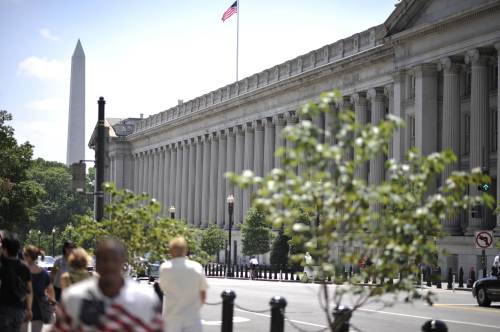WASHINGTON (AP) ― The United States’ budget deficit has topped $1 trillion for a third straight year, adding pressure on Congress and the White House to make more progress on a long-term plan to shrink the growing imbalance.
The Treasury Department said Wednesday that the deficit through July totaled $1.1 trillion. Three years ago, that would have been a record high for the full year.

The U.S. Treasury Department in Washington, D.C. (AFP-Yonhap News)
This year’s deficit is on pace to exceed last year’s imbalance of $1.29 trillion. But it is likely to fall short of the record $1.41 trillion set in 2009.
For the first 10 months of the budget year, spending has risen 2.4 percent while revenue has climbed 8 percent. That’s a sign that more people are working and paying taxes, although unemployment remains high at 9.1 percent.
Record deficits have forced President Barack Obama and Congress to create a 12-member committee of lawmakers tasked with reducing the red ink over the next decade by $1.2 trillion. If the panel cannot agree on a plan by Thanksgiving, severe across-the-board spending cuts would go into effect automatically.
The committee was a key part of a two-stage deal forged last week that allowed the government to boost its borrowing limit. The first stage of the deal would cut spending by $917 billion over 10 years. The second stage would go into effect after Congress approved the committee’s recommendations.
But the $2.1 trillion deal fell short of the $4 trillion in cuts that Standard & Poor’s said was needed to achieve a credible deficit plan. As a result, S&P downgraded the U.S. government’s credit rating from “AAA” to “AA+.”
A political backlash over the deficits allowed Republicans to gain control of the House in last year’s elections. Both parties say they are committed to reducing the deficits. But Republicans oppose tax increases; Democrats object to making big cuts to entitlement programs, such as Social Security and Medicare.
Before 2009, the deficit had never come close to $1 trillion in a single year.
The government last recorded a budget surplus in 2001, when revenues were $127 billion greater than spending. The surpluses were expected to total $5.6 trillion over the next decade.
But the country was back in the red by 2002. The deficits grew after President George W. Bush won approval for broad tax cuts, pushed a major drug benefit program for seniors and launched the invasions of Iraq and Afghanistan.
In 2008, Bush’s last full year in office, the deficit reached $454.8 billion, a record at that time. And when the economy plunged into a deep recession, the yearly imbalance topped $1 trillion.
Higher spending on unemployment insurance and food stamps, and a sharp contraction in tax revenues, widened the deficit. And it grew even more after the Obama administration backed a $787 billion stimulus program to boost the economy.
The deficit also widened after Obama and congressional Republicans agreed to extend Bush’s tax cuts for two more years and include a one-year cut in the Social Security payroll tax in an effort to give the sluggish economy a boost. Obama is seeking to extend the payroll tax cut for another year.
The fastest growing category of the budget is interest on the national debt, which totaled $213 billion through July. That’s 15 percent higher than a year ago.
Congressional leaders over the past two days have named members to the 12-member deficit-cutting panel.
House Republicans appointed Rep. Jeb Hensarling of Texas to be the co-chair. They chose Reps. Dave Camp and Fred Upton, both of Michigan, to also serve on the committee.
Senate Republicans selected Sens. Jon Kyl of Arizona, Pat Toomey of Pennsylvania and Rob Portman of Ohio.
Senate Democrats chose Sens. Patty Murray of Washington to be the co-chair. They appointed Sens. John Kerry of Massachusetts and Max Baucus of Montana to serve with her on the committee.
House Democratic Leader Nancy Pelosi has not yet announced her appointees.






![[Graphic News] More Koreans say they plan long-distance trips this year](http://res.heraldm.com/phpwas/restmb_idxmake.php?idx=645&simg=/content/image/2024/04/17/20240417050828_0.gif&u=)